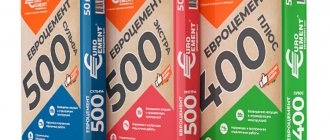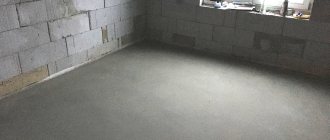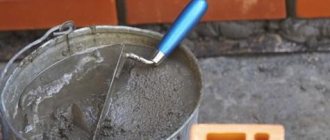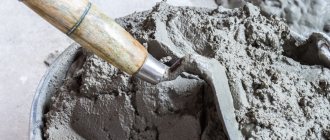Cement is an artificial building material that is actively used in various areas of construction. Cement can be used separately as a binder or in combination with other additives to create building mixtures such as concrete, reinforced concrete and the like.
The main types of raw materials from which this cement is made are:
- gypsum stone;
- clinker, a type of mineral made by sintering limestone and clay;
- waste from phosphorus sublimation or iron smelting (the so-called blast furnace charge);
- hydrophobic, acid-resistant and plasticizing additives.
The indicated components are ground finely. Next, mixing is carried out in the proportions required for a given brand.
M500 cement manufacturing technology
The raw materials for the production of Portland cement M500 are gypsum stone, clinker (a product of sintering clay and limestone), blast furnace charge, as well as plasticizing, acid-resistant and hydrophobic additives. For special types of material, some other components may be used. The technological process of cement production is divided into two enlarged stages, which in turn are divided into separate stages.
The first stage is the production of clinker, which is essentially the basis of a dry cement mixture. Clinker is obtained from a special mineral - brilliant green or yellowish-green limestone, which is mined from a depth of up to 10 m during the development of limestone deposits. Yellowish-green limestone is industrially pre-dried and then mixed with other components. After firing, the clinker is ready for subsequent technological operations.
At the second stage, the clinker is crushed to a powdery consistency with the addition of gypsum and special additives. The result is a loose, homogeneous mass. Depending on the quality and condition of the feedstock, it is possible to use one of three industrial methods for producing conditioned material: wet, dry or combined.
With the dry method, mixed raw materials are dried immediately before grinding or during the grinding process. After grinding the components into powder, the mixture is treated with burning gas. This method is now considered the most promising and economical in terms of energy consumption. The wet method involves preliminary grinding of raw materials in water. The resulting aqueous suspension is fed into the furnace and fired. At the end of the process, the formed granules are crushed to obtain the finished cement. The combined method combines both of the above technologies in different versions. Moreover, in one case, after dry preparation of the mixture, granules are formed with the addition of water, and in the other, grinding of the mixture in water is followed by its drying and firing.
How to prepare plaster correctly
The production of plaster mortar is not limited to maintaining the required ratio. Equally important is how exactly the composition is prepared. Technology must be strictly followed.
The following tips will help you do everything right.
- Each dry component (sand, lime) must be passed through a special sieve before it is added to the mixture.
- Excess components are no less harmful than deficiencies. Any deviation from the ideal proportion will degrade the quality of the final product.
- An important parameter for the quality of plaster is fat content. Its degree is determined by the instrument used to mix the composition during preparation. If the mixture sticks to it, it means it has a high degree of fat content. To return to balance, sand is added - it reduces fat content. If the composition does not stick at all, then it is skinny. The adhesion will be poor, and to improve it, binders are added. Good plaster sticks to the tool, but not too much.
A greasy mixture means that more cement was taken than needed. The composition turned out to be too thick, it will be difficult to adhere to the walls. The mixture is considered lean if, on the contrary, too little cement was taken. The result of such an error is high composition turnover.
The mass becomes normal when it is easy to apply to the surface and stays there for a long time.
Consumer qualities and main technical characteristics of M500 cement
The main operating parameter of cement, which determines its grade, is the strength of the hardened water-cement mixture, that is, its resistance to external load. Other basic characteristics of the material are its density, setting time, water and frost resistance.
2.1. Strength
It is the compressive strength of Portland cement, expressed in kg per cm2, that is included in the marking of the material, defining its type. This means that M500 cement, after mixing with water and hardening for 28 days, is able to withstand loads of at least 500 kg per square centimeter of a flat surface. This strength (in the modern classification - from 42.5 MPa) is considered high and is recognized as optimal for most critical construction work. It should be taken into account that the setting speed of the described material is shorter than that of cements of less durable brands.
2.2. Bulk and surface density
The M500 cement density parameter is necessary for rational calculation of the amount of material in the mixture during construction work. The density of the material can be bulk or true.
The bulk density of cement is the specific gravity of the loosened material, taking into account the air particles present in it. This characteristic helps to estimate the actual proportions of the solution and is used in practice. For Portland cement M500, the bulk density varies from 1100 to 1300 kg per cubic meter, but after transportation it often increases to 1400-1500 kg per cubic meter. The true density of cement is determined by the specific gravity of the mixture without air particles. It exceeds the bulk volume by almost 2 times and for M500 cement is about 2500 kg per cubic meter.
To calculate the amount of ingredients of a concrete-mortar mixture, a volume-measured amount of material is poured into a separate vessel, then it is weighed and the result is divided by the volume of the container. In a similar way, determine the required amount of additives in the solution (sand, etc.). Typically, in mass construction, an average bulk density of 1200-1300 kg per cubic meter is used. The average weight of a cube of Portland cement M500 is 3 tons with a standard grinding fineness of 92%. At the same time, gypsum additives lighten the volume, and slag additives make it heavier.
2.3. Frost resistance
For M500 grade material, the guaranteed frost resistance is at least 70 cycles of complete freezing-thawing of the hardened mixture (F70). Thanks to this, the material can be used in regions with sharp climatic changes, including for winter concreting.
2.4. Water resistance
M500 cement without impurities has normal water resistance, allowing it to be used in the construction of residential, office and industrial buildings. However, when constructing foundations, swimming pools and other concrete tanks, it is recommended to use material with index D20, which contains special additives that are responsible for the additional resistance of the mixture to constant exposure to moisture.
2.5. Setting time of liquid mixture
Portland cement M500 is a material with accelerated hardening, which makes it possible to effectively use it both in conventional construction and in the process of repair and emergency work. In this case, the strength qualities of the mixture begin to appear no later than 45 minutes after use, the initial hardening occurs after 10-12 hours, and 50% hardening occurs in three days.
Consumption rates
The grade of cement is the main parameter that determines the required amount of mixture used to create a cubic meter of concrete. The higher the grade, the less cement is required and, in general, using higher grades is more economical.
Thus, in terms of the amount of material consumed, M500 is one of the most profitable, since to obtain concrete of a certain strength, 15-20 percent more low-grade cement is required.
There are common proportions that are used to produce concrete from a cement-sand mixture.
These proportions vary depending on the purpose of the concrete being created. The main varieties include the following:
- for structures that require high strength , that is, foundations, floors and the like: 1 part cement to two parts sand;
- for masonry mortars: 1 part cement to 4 parts sand;
- For areas where significant load is not expected , such as floor screed, garden paths and plaster, use a ratio of 1 to 5 cement and sand, respectively.
When using mixtures that were created more than thirty days prior to mixing, a reduction in performance should be considered.
Every four weeks, the brand reduces about ten percent of activity, that is, for example, a fresh M500 after a couple of months in terms of functional characteristics is equal to M400 and the proportions for this brand should be used, that is, in quantities 15-20% more.
Pure cement M500 and its special types
Pure or clinker cement M500, free from mineral additives and impurities (index D0), has a fairly low cost and is widely used in construction. Masonry and industrial concrete structures using it can withstand static loads well, are strong, durable and frost-resistant. Construction experience shows that the reliability of buildings based on M500 Portland cement is much higher than those using M400 material.
Certain types of material are produced with a standardized content of modifying or technological additives, which help speed up the grinding process of the gypsum-clinker mixture, increase the frost and moisture resistance of the hardened material, accelerate hardening, etc.
Among the special types of M500 cement offered on the domestic market, the following are actively used:
- fast-hardening cement BTC, in demand in high-speed construction;
- sulfate-resistant Portland cement SSPC, used in the construction of massive foundations, dams, piers and structures that are under constant influence of groundwater with sulfates;
- material with surface-active components (PL) with increased plasticity;
- GF cement with minimal water permeability, used in specific conditions;
- Portland cement VRC (waterproof expanding) with high density, used in mine structures and when sealing cracks in water pipes;
- grouting cement for plugging boreholes;
- decorative colored cement white (BC) or colored.
The weight amount of additives in M500 cement relative to the original clinker mixture according to the state standard can be in the range of 0-20%, which is reflected in the factory marking of the material after the letter D.
Manufacturers
Cement production enterprises are located in almost every region of Russia. Proximity to the manufacturer will significantly reduce the costs of transporting large quantities of cement. In addition, at regional factories, various substances are added to cement that improve the physical and mechanical properties of structures, taking into account the specific weather and water conditions of the area.
Here are some examples of businesses located in different regions:
- Association "Yakutcement" - Republic of Sakha.
- Podolsk cement plant - Podolsk, Moscow region.
- Teploozersky cement plant – Jewish Autonomous Region.
- Novotroitsk cement plant - Orenburg region, Novotroitsk.
- Verkhnebakansky cement plant - Krasnodar region, Novorossiysk.
There are dozens of similar enterprises. There are also large manufacturers on the market, known throughout Russia and even in Europe. For example:
- Mordovcement offers grade 400D20 in 40 kg bags. This product has increased corrosion resistance and is more frost-resistant. Average price – 200-230 rubles.
- Eurocement unites a group of manufacturing enterprises, therefore it offers a wide range of products. M400 cement can be bought in packages from 25 kg to 1 ton. Price - about 220 rubles. for 50 kg.
Marking of cement M500 according to old and new GOST
Marking of Portland cement M500 is still carried out either according to the outdated state standard GOST 10178-85 or according to the updated GOST R 31108-2003 with additions from 2016.
In the first case, the initial letters of the designation will be PTs (Portland cement) or ShPTs (slag Portland cement), followed by the index M500, indicating the grade of material. In this case, the letter M is often skipped. This is followed by information about the percentage of impurities - D5, D10, D15, D20, and then about the special properties of cement. An example of such marking is PC-500-D10-SS GOST 10178-85, that is, Portland cement grade 500 with ten percent impurities, sulfate-resistant.
According to the GOST R 31108-2003 standard, consistent with European standards EN 197 1, the strength properties of cement are expressed in megapascals (MPa). In the domestic version, the marking of the material begins with the letters CEM followed by the Roman numeral I or II, respectively, indicating the absence/presence of mineral additives in it. Here, number I means cement made from ground clinker and technological additives in an amount of up to 5% by weight of the material, and number II means the presence of additives in a mass fraction of 6%-35%. Portland cement with impurities has an additional index A (6%-20% additives) or B (21%-35% additives). At the end of the designation there may be a letter N or B, indicating the rate of hardening of the mixture - normal or fast. An example of such marking for M500 cement is CEM II/A 42.5N, that is, M500 cement with a proportion of impurities of 6%-20% and a normal hardening rate.
Pros and cons of the material
Among the operational advantages of Portland cement M500, which make the material attractive for various areas of construction activity:
- ease of use, since here the preparation of the solution comes down to thoroughly mixing a mixture of water, cement, sand and, if necessary, crushed stone in specified proportions;
- chemical inertness, which implies resistance of finished concrete products and building structures to corrosion, exposure to alkalis, salts and acids;
- environmental friendliness, since the material does not contain toxic substances, the fumes of which can cause harm to humans and the environment;
- the optimal combination of strength, moisture resistance and durability of finished structures;
- moderate consumption of building materials, helping to minimize the developer’s costs.
The only significant drawback of M500 cement is its cost, which is slightly higher than that of lower grades of material. This partly constrains its use in the construction of unloaded structures and buildings that are not subject to special external aggressive influences.
Types of plaster
The purpose of the final product affects the ingredients used and their ratio:
- To treat external walls, a composition of cement, lime and sand is created. The same composition is suitable for coating interior walls in wet areas, for example, in showers, bathrooms, and basements.
- If the expected indoor or outdoor humidity level is low, plaster is made from cement, sand, clay and gypsum.
- There is a special composition for medium humidity levels. Clay and cement are added to it.
Areas of application of Portland cement M500
The working properties of M500 cement have determined the wide range of applications of the material. Among the areas of mass use of building mixtures based on it:
- construction of foundations for residential multi-storey and capital industrial construction projects;
- construction of shopping centers, large-capacity warehouses, port facilities, train stations and public buildings, including on water-saturated soils;
- repair and emergency restoration work on concrete structures and buildings;
- construction of overpasses, bridges, dams, locks, power line supports;
- development of high-traffic highways;
- production of massive reinforced concrete slabs (airfield, road, etc.).
In addition, Portland cement M500 is used in special cases when mixtures with rapid hardening and guaranteed strength are needed (creating floor screeds, decorative park elements, etc.).











